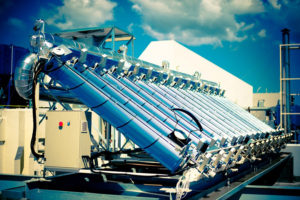Heat exchangers in concentrated solar power
Heat exchangers are employed as well in the field fo renewable energy. An interesting application developed in Tempco is related to the installation of a heat exchanger within a test bench for an innovative concentrated solar power plant. The concentrated solar power technology employs a concentrator, or solar collector, that uses mirrors and lenses to concentrate a large area of sunlight onto a receiver. Especially shaped reflective panels direct solar radiation onto the narrow surface of a tube receiver, or absorber, inside which there is a liquid flowing, a thermal vector fluid. The fluid collects the heat, thermal energy, which is usually converted into electric power, using water-steam thermodynamic cycles.
Tempco was in fact contacted for the project of a parabolic trough collector (PTC), developed within an academic research team in the Italian Marche Region. The project required to measure the efficiency of the system using a dedicated test bench equipped with a heat exchanger as core component of the solar collector, offering some quite defined characteristics. The test bench, called PTC.TestBench, needed to be able to test solar collectors in a wide range of temperatures, from 15 to 150° C, and working with both diathermic oil and water as heat transfer fluids. In addition, the team noticed that different levels of thermal duty needed to be dissipated using the same fluid flow rate on the primary circuit of the heat exchanger.
According to the requirements of the application, a plate heat exchanger has been designed and sized upon the most challenging working conditions, and verified for all the possible load rates. Nickel brazed plates have been employed, to withstand the high temperature levels involved and to avoid corrosion in presence of demineralized water. The exchanger allows to achieve testing cycles using both water, in a working temperature range between +30 and +75° C, and oil, in a broader working temperature range up to 150° C.




 Back to index
Back to index Download the complete book
Download the complete book